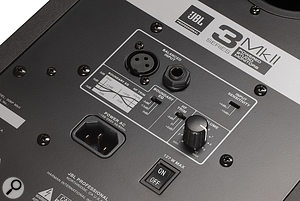Part of JBL's 3 Series of monitor speakers, the 306P MkII is an affordable two-way active design that aims, via JBL's proprietary transducer and circuit technologies, to combine accuracy, low-frequency extension, and reasonably high SPL capability. Key elements of the design are JBL's Image Control Waveguide and flared Slip Stream low-frequency port, which together aim to keep the frequency response as flat as possible over a wide listening angle, while delivering a clean low end. (As the port is on the rear of the cabinet, the speakers shouldn't be placed too close to a wall. I'd be inclined to get them no closer than 300mm.) Because the waveguide keeps the off-axis frequency response as even as possible, room reflections come back relatively uncoloured, which should help to some extent in rooms with marginal acoustic treatment (though proper treatment will make them perform rather better!).
This particular model includes a magnetically shielded, 6.5-inch mid/low-frequency transducer with a 1.5-inch voice coil, and a self-repairing dust dome that smooths out any accidental dents all by itself. (I gave it a gentle prod to test that claim and all seems well!) By reducing thermal-related effects such as power compression, the monitors are able to perform consistently over the full range of listening levels. A continuous rated SPL of 98dB is quoted along with peak SPL handling of 110dB at one metre (pink noise, C–weighted).
A pair of Class–D amplifiers, each rated at 56W, is used to drive the woofer and the magnetically shielded soft-dome tweeter, crossing over at 1.425kHz following a fourth-order Linkwitz–Riley curve. A frequency response of 39Hz to 24kHz is specified — but I note that this is measured at the -10dB points, not the more common -3dB points. For use as part of a larger full-range system, the 306P MkII is compatible with JBL's LSR310S active subwoofer, which itself takes care of crossover duties.
 Constructionally, the speakers are presented in conventional cabinets, built from 15mm MDF and finished with a thin black PVC skin. The baffle, which includes the waveguide, is injection–moulded from structural ABS. Overall the cabinets measure 408 x 285 x 328mm and weigh 6.1kg each. Connectivity is via balanced XLR or quarter-inch TRS jack with +4dBu/-10dBV sensitivity switching, and level adjustment is via a detented rotary control. Room and placement correction is catered for via the LF Boundary EQ (-3, -1.5 and 0 dB) and HF Trim (-2, 0, and +2 dB) slide switches, and a small graph nearby displays the effect of these filters. Power comes via a standard IEC socket, and there's also a power switch.
Constructionally, the speakers are presented in conventional cabinets, built from 15mm MDF and finished with a thin black PVC skin. The baffle, which includes the waveguide, is injection–moulded from structural ABS. Overall the cabinets measure 408 x 285 x 328mm and weigh 6.1kg each. Connectivity is via balanced XLR or quarter-inch TRS jack with +4dBu/-10dBV sensitivity switching, and level adjustment is via a detented rotary control. Room and placement correction is catered for via the LF Boundary EQ (-3, -1.5 and 0 dB) and HF Trim (-2, 0, and +2 dB) slide switches, and a small graph nearby displays the effect of these filters. Power comes via a standard IEC socket, and there's also a power switch.
JBL have a reputation for very detailed-sounding speakers that have, on occasion, been a hint bright, but the 306P MkIIs sound less 'toppy' than many JBLs I've reviewed, most of which have metal-domed tweeters. The use of a soft-dome tweeter here keeps the highs from sounding aggressive, then, but I was still impressed by the clarity and detail, as well as the excellent stereo imaging and usefully wide sweet spot. That slightly unusual horn flare, which I'm pretty sure is a spin-off from JBL's high-end studio monitors, seems to do the job.
The use of a soft-dome tweeter keeps the highs from sounding aggressive, but I was still impressed by the clarity and detail delivered by these speakers.
Considering that this is a ported cabinet — ports essentially buy speaker designers some extra LF extension at the cost of a degree of time smearing — the bass sounds full, solid and well-controlled. My tests were done sitting the speakers on a pair of Primacoustic Recoil Stabilizer platforms; a decent support is essential to keep the bass end as tight as possible. The four self-adhesive rubber feet that come with the speaker really don't do it justice on their own but may be useful in stopping the speaker slipping when placed on a suitable platform or stand.
While not quite entry–level in price (they fall in a similar price bracket to the PreSonus Eris range and some models from Mackie, ADAM, Eve, ESI and Fostex), these speakers are by no means expensive, and they deliver a very strong performance for their price. They offer a good overall tonal balance, sound less forward than previous JBLs, and yet are still very revealing of detail. I found myself really enjoying them, and I'd be confident using them for serious mixing. So if you're shopping around for home-studio monitors, give these a listen — they stack up well against many speakers that cost considerably more.
information
$238 per pair (discounted price when going to press; regular price around $299 per pair).

